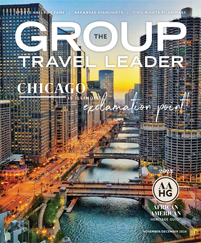Stories about Henry Wadsworth Longfellow’s childhood, John F. Kennedy’s wedding and a jail designed to mimic an upscale mansion can make a trip to the beach more than just a pretty picture. Coastal cities founded well before the U.S. government existed offer intriguing tales from the past that can delight groups.
These towns captivate not only with stories from the history books but also with their preserved architectural structures, from Spanish missions to Gilded Age mansions. History feels present on a walk through these coastal towns.
Groups can admire the grand homes, learn about fascinating former locals and soak in the enduring beauty of the beach at these historic coastal cities.
St. Augustine, Florida
Motorcoach groups in St. Augustine, Florida, sometimes hear a sudden bang on the bus door. When the door opens, in walks a woman in a nightgown carrying a Ouija board. The Crazy Ida Alice Tour takes groups by surprise and then holds their attention as the step-on guide plays the character of one of Henry Flagler’s eccentric wives. During the ride, groups listen to how a Spanish colonial city founded in 1565 became the architecturally significant destination it is today.
Though the city is the oldest continuously occupied European-established settlement within the borders of the continental United States, the northeastern Florida city owes much of its current popularity to Flagler. A partner and co-founder of the Standard Oil Company with J.D. Rockefeller, Flagler decided to turn the city into a winter playground for the rich during a honeymoon there with his wife, Ida Alice.
Flagler radically altered the appearance of St. Augustine with Moorish Revival-style structures he began constructing in 1887. To avoid spoiling the ornate feel of the city, Flagler even designed the St. Augustine Old Jail to blend in as a Victorian home with its pink exterior and front porch.
Today, groups can choose from several ways to discover the city: step-on guide, cruise, trolley or dinner performance.
“We don’t have a dinner party per se, but we do have theater companies that will do performances for groups while they are having dinner,” said Evelyn Vasquez, director of leisure sales for the St. Augustine, Ponte Vedra and the Beaches Convention and Visitors Bureau. “We have titles like ‘Murder in the Old City’ and ‘The Wives of Henry Flagler.’ During dessert, the group can watch the show, and then the next day, they can do a tour of hotels that Henry Flagler actually built.”
Groups can wander through Flagler’s former Hotel Ponce de Leon, now part of Flagler College, and see other historic attractions, like the Memorial Presbyterian Church, St. George Street and the Castillo de San Marcos.
Portland, Maine
Longfellow first developed literary aspirations while spending his youth along the shores of Portland, Maine. Groups can learn how Portland shaped this influential American poet at the Wadsworth-Longfellow House.
Virtually all the house’s furniture and artifacts originated with the Wadsworth and Longfellow families. Portland remains proud of its native poet as well as its maritime history, since the town served as a booming shipping port from 1789 through World War I, primarily because of its position as the trans-Atlantic port closest to Europe in the United States.
“Portland fits into the larger scope of American history,” said Robert Witkowski, creative director of media relations for Visit Portland. “There are so many historic things to do. We have a great city in both size and accessibility for groups of different sizes. People can go their own way and do their own thing but not be scattered too far.”
Groups can immerse themselves in the past with the Architectural Walking Tour of Portland’s four historic neighborhoods. As participants walk past neighborhoods filled with cobblestone streets and red-brick buildings dating from the late 1860s, guides discuss how Maine’s largest city evolved from a small British colony to a mecca of American commerce.
The Portland Observatory showcases this seafaring past with a tour of its museum and 1807 maritime signal tower, the only known surviving tower of its type in the country. Groups can also examine the area’s history at Fort Scammel, the Victoria Mansion, the Tate House and the Neal Dow House.











